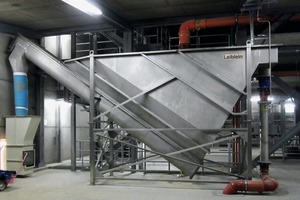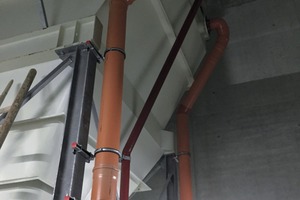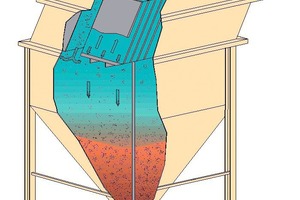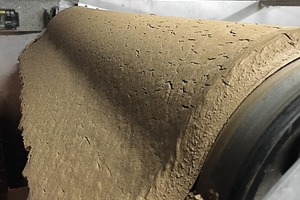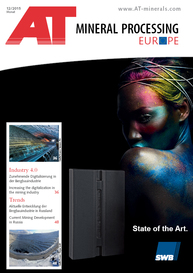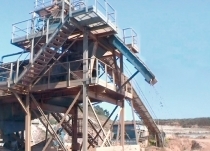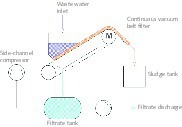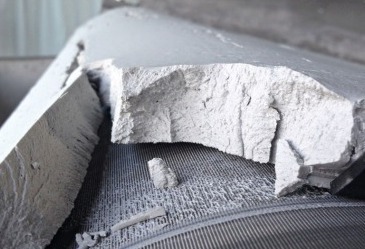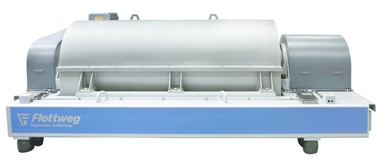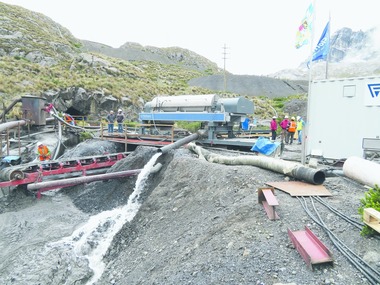Wet processing with a closed water circuit
The product range of Schaefer Kalk, a company based in the German state of Rhineland-Palatinate, goes from limestone through calcium oxide and calcium hydroxide to ready-to-use milk of lime, along with fillers as well as pigments for special applications. To meet the high quality requirements for Schaefer Kalk products, the company is always investing in new production technology, like the new processing equipment for limestone at the Hahnstätten Plant, in the Rhine-Lahn district of Germany.
The production line comprises a crusher in which the limestone is crushed and screened. Camera diagnostics are used to check the quality, and any rejects are removed by means of compressed air. On a 500-m-long enclosed belt conveyor, the material is transported after wet processing with a closed water circuit to the kilns.
Cleaning washing water and dewatering sludge
Building on the cleaning and filter expertise of Leiblein, the Baden-Württemberg-based plant engineering specialist, the concept was defined including cleaning of the washing water from “kiln brick” processing and dewatering of any sludge produced. With a combination of solids separator (Fig. 1), lamella clarifier as well as a vacuum belt filter – used selectively during the process water circuit – the objectives could be met in all respects.
The water circuit starts with the water from the processing plant, which – in free fall and mixed with coarse components from approx. 0.1 to 5 mm – flows into the solids separator to remove the coarse components.
The solids separator in the clarifying process
The process water is introduced into the tank from the top and flows downwards. There it is diverted and led upwards over lamellas to flow out of the tank via a weir. The sedimentable particles are separated out of the water as it flows over the lamellas. From there, the solids slide downwards into the sludge funnel, while the cleaned water flows over the discharge weir. A screw is used to transport the settled sludge above the water level to be transported to a stockpile via tanks. Once it passes the solids separator, the process water flows downwards into the Leiblein lamella clarifier (Fig. 2).
The lamella clarifier, filter technology for optimum results
Similar to the solids separator, in the lamella clarifier, the water flows from the inlet downwards, and is then diverted and led upwards over a set of lamellas. (Fig. 3). Here the suspended solids settle on the inclined lamellas (sedimentation) and slide into the sludge funnel. For the lamella clarifier and its demanding clarifying task at Schaefer Kalk, an installation area of just around 3 x 4 m was necessary.
Despite the small space requirement – a conventional circular thickener would have needed 12 m in diameter – the throughput rate is designed for 100 m³ water per hour. The low space requirement is accompanied by a minimized use of flocculants, just 70 % compared to 100 % for a circular thickener. The use of sludge level measurement ensures that the required paste-like consistency is obtained, to reliably pump the thickened sludge in the direction of the vacuum belt filter, to maximize sediment discharge.
The vacuum belt filter dewaters the sludge
This type of filter features continuous filter belts made of stainless steel with a fineness from 80 µm, which operates with vacuum assistance. In the following, a high throughput rate and better dewatering of the filter cake can be achieved (Fig. 4).
With all filter variants in the water circulation, a very high fresh water saving is achieved, as only 5 to 10 % freshwater has to be added to compensate for any water losses caused by it sticking to rock or the residual water content in sludge.
With the precise planning and prefabrication, installation on site was limited to just a few days. In addition, the Leiblein filter at Schaefer Kalk is based on a modular concept so that if the volume of water increases, more lamella clarifiers can be integrated. The filter efficiency for limestone processing at Schaefer Kalk’s Hahnstätten plant has received unanimous approval and supports the standards there for economical use of water as a resource to protect the environment.
$(LEhttp://

